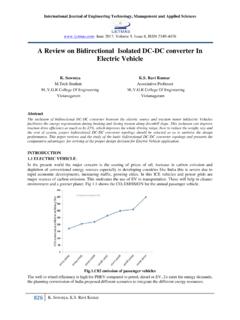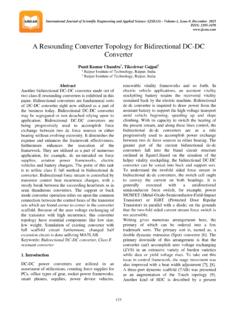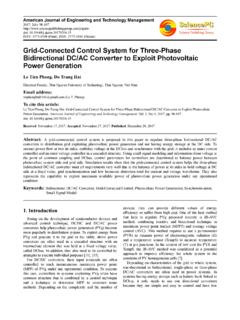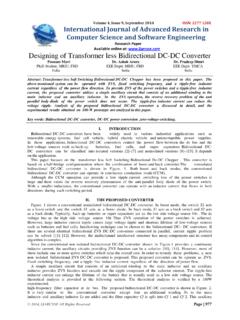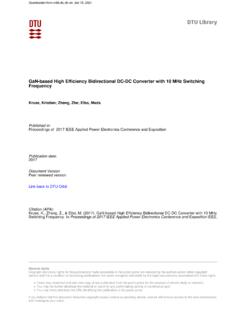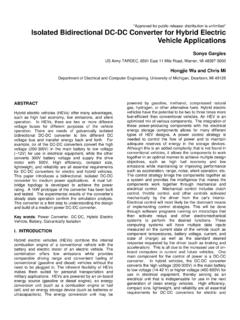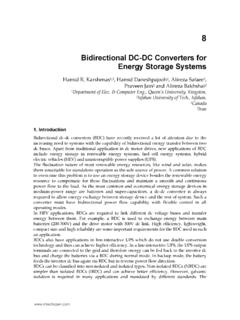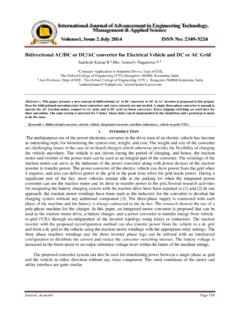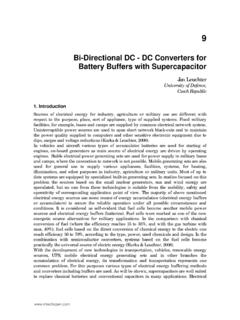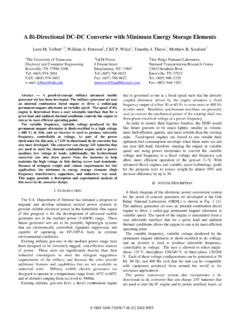Transcription of High Gain Zero Voltage Switching Bidirectional Converter ...
1 ISSN 2321-8665 , , October-2016, Pages:2833-2839 Copyright @ 2016 IJIT. All rights reserved. High Gain zero Voltage Switching Bidirectional Converter with Reduced Number of Switches K. KRISHNAIAH1, NIREEKSHAN2, S. RAJESH3 1PG Scholar, Dept of EEE, Siddhartha Institute of Engineering and Technology, Ibrahimpatnam, Hyderabad, Telangana, India. 2 Assistant Professor, Dept of EEE, Siddhartha Institute of Engineering and Technology Hyderabad, Telangana, India. 2 Assocoaite Professor & HOD, Dept of EEE, Siddhartha Institute of Engineering and Technology Hyderabad, Telangana, India. Abstract: A non-isolated Bidirectional DC-DC Converter has been proposed in this paper for charging and discharging the battery bank through single circuit in applications of Uninterruptible Power Supplies (UPS) and the hybrid electric vehicles.
2 The proposed Bidirectional Converter operates under zero Voltage Switching (ZVS) condition and provides large Voltage diversity in both the modes of operation. This enables the circuit to step up the low battery bank Voltage to high DC link Voltage and vice versa. The Bidirectional operation of the Converter is achieved by employing only three active switches, a coupled inductor and an additional Voltage clamped circuit. Complete description of the operation principle of the circuit is explained and design procedure of the Converter has been discussed. The experimental results of a 300W prototype of the proposed Converter confirmed the validity of the circuit.
3 The maximum efficiency of 96% is obtained at half load for boost operation mode, and 92% for buck mode of operation.. Keywords: Bidirectional DC-DC Converter , zero Voltage Switching (ZVS), Coupled inductor. I. INTRODUCTION Bidirectional DC-DC Converters are widely used in many industrial applications such as hybrid vehicles, auxiliary supplies, and in battery charging/discharging DC converters in UPS system. Usually battery bank are the backup energy source which provides very low Voltage at the input of the Bidirectional Converter . Although, a string of batteries connected in series can provide a high input Voltage , but still it has some disadvantages.
4 A larger battery bank increases the size and cost of the system. Also if there is a slight mismatch in the batteries Voltage or difference in the batteries temperature within the string, it will cause charge imbalance in the battery bank [1]. This study therefore focuses on the analysis and design of a high efficiency Bidirectional Converter with high Voltage conversion ratio, which helps in reducing the number of batteries in order to elude a larger battery bank. The Bidirectional Converter may be transformer isolated [2] or non-isolated [3-10]. Isolated bridge-type Bidirectional converters are probably the most popular topology in high power applications.
5 However, the major concerns of this topology are high Switching losses, excessive Voltage and Current stresses, and significant conduction losses because of the increased in the number of switches [6]. Hence, their practical implementation is quite complex. With incorporation of coupled inductor and zero Voltage Switching (ZVS), Non-isolated Bidirectional converters has attracted special interest due to high conversion ratio, reduced Switching losses, and simplicity in design. These types of topologies are highly cost effective and acceptable due to high efficiency improvement, and considerable reduction in the weight and volume of the system.
6 Several topologies of the non-isolated converters have been proposed so far [3-6]. A ZVS Bidirectional Converter with single auxiliary switch has been proposed in [3]. Although the main switches operate under ZVS which increase the efficiency of the system, but the auxiliary switch still performs hard Switching and the Converter offers very limited Voltage diversity [7]. Other high Voltage gain Bidirectional converters have been proposed in [8-11]. These converters provide high Voltage gain in both the boost and buck mode of operation but at the cost of high number of active switches and extra auxiliary circuit components used in the circuit.
7 This adds more complexity in the control circuitry, with high size and cost. According to the analysis of the drawbacks related to the aforementioned topologies, this paper proposes a new non-isolated Bidirectional DC-DC Converter with coupled inductor. The proposed Converter has following advantages. 1. High Voltage Gain in both the buck and boost mode 2. Only three active switches are used to perform Bidirectional operation. 3. Less number of passive components is used in the circuit 4. zero Voltage Switching (ZVS), synchronous rectification, and Voltage clamping circuit are used which reduces the Switching and conduction losses.
8 This paper is organized as follows: the operation of proposed topology is explained in section II. Design considerations are presented in section III, followed by experimental results in section IV and conclusion in Section V. K. KRISHNAIAH, NIREEKSHAN, S. RAJESH International Journal of Innovative Technologies , Issue , October-2016, Pages: 2833-2839 II. OVERVIEW OF BLDC MOTOR Input inverting stage of BLDC motor. The control of PMBLDC motors can be accomplished by various control techniques using conventional six pulse inverters which can be classified in two broad categories as Voltage source inverter (VSI) and current source inverter (CSI) based topologies.
9 The controllers can further be divided on the basis of solid state switches and control strategies. The BLDCM needs rotor-position sensing only at the commutation points, , every 60 electrical in the three-phases; therefore, a comparatively simple controller is required for commutation and current control. The commutation sequence is generated by the controller according to the rotor position which is sensed using Hall sensors, resolvers or optical encoders. These sensors increase the cost and the size of the motor and a special mechanical arrangement is required for mounting the sensors.
10 The components are DC-AC inverter, DC-DC Converter , battery, and electric BLDC motor. DC-AC inverters supply Voltage to the electric motor from the battery and also supply utility loads such as air conditioning and AC power outlet. Driving process of high Voltage BLDC motor. DC-DC converters supply Voltage to various vehicular loads set to operate at different voltages. In the near future, high power DC-DC converters will be needed for EVs since the vehicular power requirements are continuously increasing due to which the present day 12- V/14-V electrical system will be replaced by 42-V/300-V architecture.
